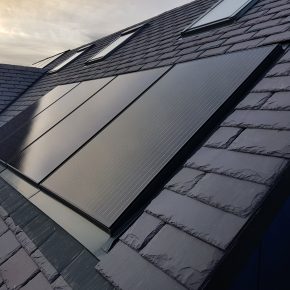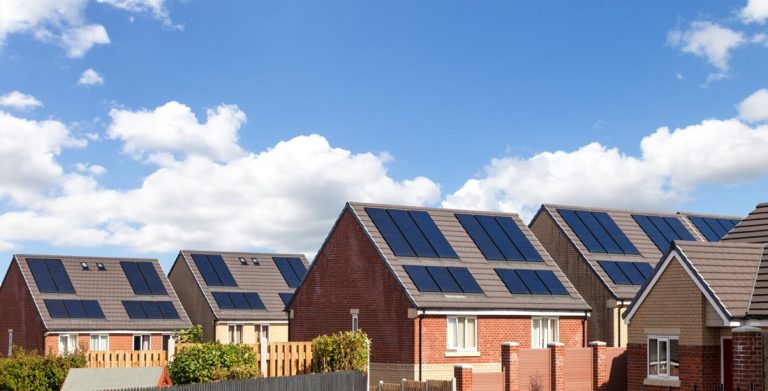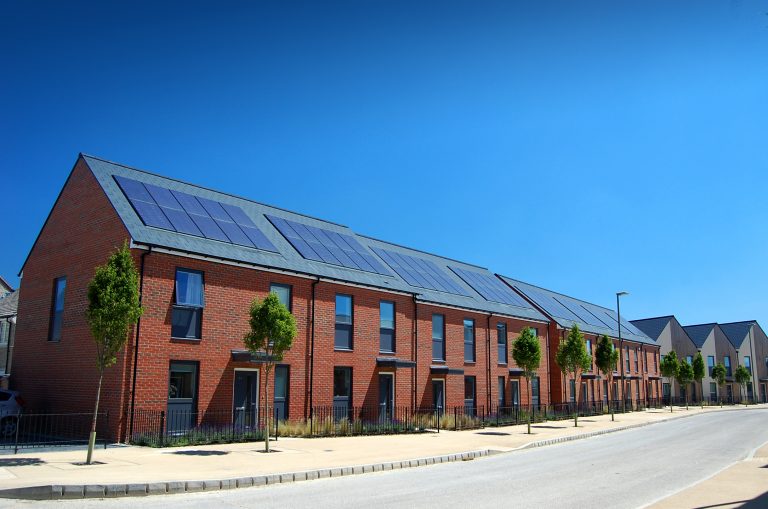
Seven solar predictions from Marley on renewable roofs of the future
Stuart Nicholson, roof systems director at Marley, shares seven predictions on the renewable roofs of the future and what will change in the solar industry across the next year, five years, and decade…
This year
Battery technology and solar storage becomes the new norm in residential/domestic installations
Solar storage will be one of the biggest concerns for those with PV installations in 2024. With uncertainty around feed-in tariffs and energy costs, the guarantee of selling back to the grid being a profitable outcome for those with excess solar energy generated will not be there. Especially given that Ofgem has recently announced a 5% price cap increase on the previous quarter, from 1 January to 31 March 2024.
For those with solar PVs already, this will mean investment in batteries and energy storage solutions are more essential. And for those considering solar panels or tiles, a storage option will strengthen the cause for renewable investment as energy costs and fears for power outages grow too; as battery storage could reduce energy costs by 80-90%.
In some European countries, like Switzerland, Italy and Austria, solar systems having built-in storage is already more of the norm. In Germany, more than two thirds of the newly installed solar systems (on private property) are installed together with a storage system[1].
It’s exciting to see it heading that way for the UK too; battery storage take-up has increased exponentially in the last 18 months, with 90% of domestic retrofit solar installations now compatible with incorporating a battery[2]. Given that 2023 has so far been a record year for solar – with the milestone of 84MV of solar capacity installed reached in June 2023 – the demand for storage will continue to grow in the residential sector.

Solar panels become the norm on new builds
We will start seeing the true impact of the Part L changes – which came into effect June 15th 2023 – during the year ahead. It was disappointing to witness the spike in housing starts in Q2 2023, which was by far the highest number of starts throughout the whole year (and on record in England[3]), as housebuilders tried to beat the Part L changes.
Subsequently the number of solar installations across the UK last year was disappointing. However, as these houses get completed from Q2 last year, the Part L changes will really take effect and we will see solar panels becoming the norm on most new builds and homes during 2024.

In the next five years…
Solar panels will become incentivised or compulsory in retrofits and on new builds
The government has set targets to reach 70GW of solar capacity by 2035, and in five years’ time we’ll be halfway to this target on the timescale. In order to ensure we reach these goals in the UK, it is likely that building regulations will alter to include compulsory installation of solar panels on new builds, as is the case in countries like Japan, and being considered in San Francisco already to incentivise installation.
Part L regulations are changing in the future, and from 2025, the Future Homes Standard will mean a 31% reduction in emissions compared to current standards for new homes. Renewables are one big step towards achieving this, and could lead to a significant increase in new homes incorporating solar technology.
It presents an opportunity within the roofing industry too for contractors to upskill their workforce to fit solar systems. To future-proof this strategy and meet customer demand, it is even possible that renewables may go beyond ‘standard’ or ‘the norm’ and potentially even become mandatory by regulation on new builds within the next five years.
Aside from the new builds sector, there is a huge renewable opportunity on the housing stock that is coming to the end of its life. With the housing boom in the 50s and 60s, there were around 400,000 houses built a year; fast forward 70+ years to now, and many of these buildings are now in need of a new roof or upgrade.
This represents a proportion of the UK housing stock that could be retrofitted with solar during maintenance and upgrades as it would be convenient and in some places cheaper to install roof renewables at the same time as a replacement roof. In five years from now, we could expect to see government incentivisation to support this demographic in the housing market with renewable upgrades, perhaps in a similar way to the Boiler Upgrade Scheme.
Solar targets for electricity generation increase to around 12%
Currently, according to data from the Government Energy Trends Report from June 2023, solar accounts for only 2.3% of the renewable energy share of electricity generation, despite renewable energy being responsible for 47.8% of UK energy generation in the first quarter of 2023[4]. In the next few years, as solar becomes increasingly attractive with batteries, compulsory built-in regulations, and cheaper installation, this could increase from a 2.3% electricity generation share to around 15%, and outperform bioenergy, and edge closer to offshore wind production which was 19.2% for Q2 2023.
Solar will be incorporated alongside an increase in modular and off-site house buildings
The government’s previous long-held target and ambition of building 300,000 homes every year is at a shortfall, and only reached 233,000 in 2021/22[5], with further reductions expected for 2022/23. Last year (2023), there was a reduction in houses being built, and the downturn in the market meant many off-site manufacturers struggled to stay afloat, and the modular manufacturing sector was massively impacted.
However, if the incumbent government has ambitious plans to build circa 300,000 houses, this can only be achieved with modular and off-site manufacturing. And with this, comes the opportunity for wider greener goals and net zero ambitions to be met simultaneously, with a modular fit of solar panels to these new buildings and homes. This would be cheaper than retro-fit installations down the line to have solar and renewables installed from the start.
In the next ten years (2034)…
Huddles of green home estates as they power surrounding areas
Developers and architects are incorporating renewable energy into new build designs already as net zero goals loom. In the next decade, we can expect to see this taken to a higher level with ‘green estates’ or ‘renewable villages’ as they embrace solar and heat pumps for power as a collective. In cities with limited space to enable full solar PV installation and older buildings, these estates and huddles could likely be storing power and supplying bigger cities through local council payback schemes.
Solar walls and windows becomes popular on south facing buildings
Solar works best with south facing homes in the UK. It’s likely in the next decade that solar will have developed beyond roof panels to include more solar walls or window frame features. Our solar tiles at Marley are popular for their more discreet appearance, and design development of solar will make it possible to have ‘solar bricks’ and features that help those with solar on east or west facing homes to better capitalise on sunlight and solar production.
Data references
Latest news

28th March 2025
FLIR Si1-LD Acoustic Imaging Camera for Compressed Air Leak Detection
FLIR, a Teledyne Technologies company, introduces the Si1-LD, an industrial acoustic imaging camera that brings faster and more accurate compressed air leak detection to those operating on a modest condition monitoring budget.
Posted in Acoustics, Noise & Vibration Control, Articles, Building Industry News, Building Products & Structures, Building Services, Facility Management & Building Services, Information Technology, Innovations & New Products, Retrofit & Renovation, Sustainability & Energy Efficiency, Thermal Imaging and Monitors
28th March 2025
LIFTEX 2025 Seminar programme announced
Registration has opened for LIFTEX 2025. Now in its 37th year, LIFTEX 2025 is the UK’s only dedicated exhibition for the lift, escalator and access industry and takes place only once every three years.
Posted in Access Control & Door Entry Systems, Accessibility, Articles, Building Industry Events, Building Industry News, Building Products & Structures, Building Regulations & Accreditations, Building Services, Exhibitions and Conferences, Facility Management & Building Services, Health & Safety, Retrofit & Renovation, Security and Fire Protection, Seminars
28th March 2025
MCRMA welcomes ArcelorMittal UK to membership
A UK division of the global steelmaking business ArcelorMittal has become the latest new member of the MCRMA, the industry association representing the metal building envelope sector.
Posted in Articles, Building Associations & Institutes, Building Industry News, Building Products & Structures, Building Systems, Cladding, Facades, Posts, Restoration & Refurbishment, Retrofit & Renovation, Roofs, Steel and Structural Frames, Walls
28th March 2025
Abloy: Managing access and security in Telecoms infrastructure
Telecommunications infrastructure underpins much of the world’s economy and critical services, but the industry is vulnerable to physical threats, from sabotage to theft and accidental damage, as Abloy UK explains here…
Posted in Access Control & Door Entry Systems, Architectural Ironmongery, Articles, Building Industry News, Building Products & Structures, Building Regulations & Accreditations, Building Services, Doors, Facility Management & Building Services, Information Technology, Innovations & New Products, Posts, Publications, Research & Materials Testing, Retrofit & Renovation, Security and Fire Protection
 Sign up:
Sign up: